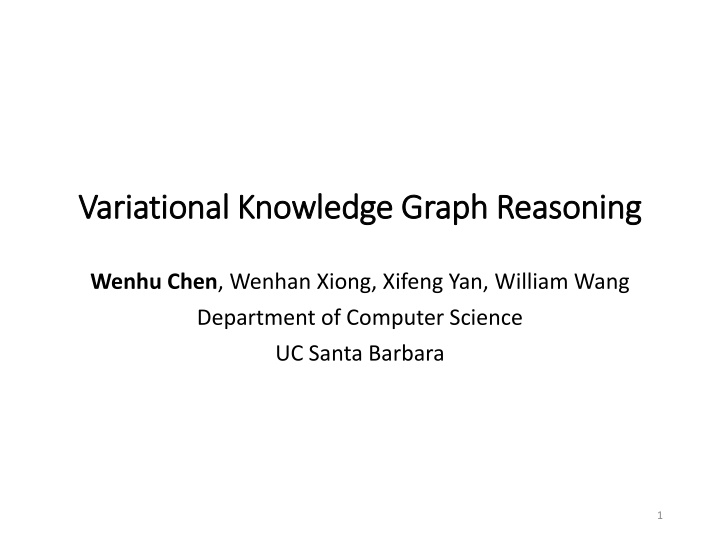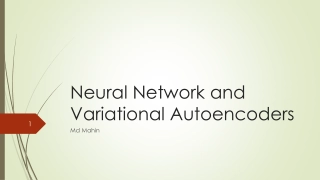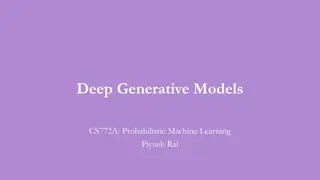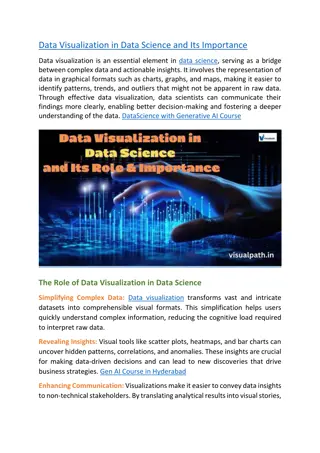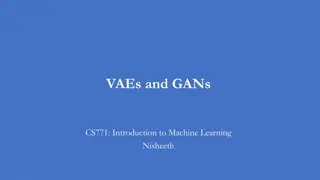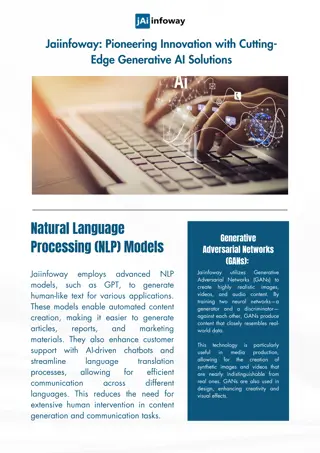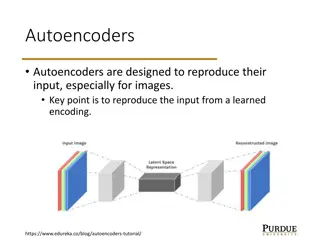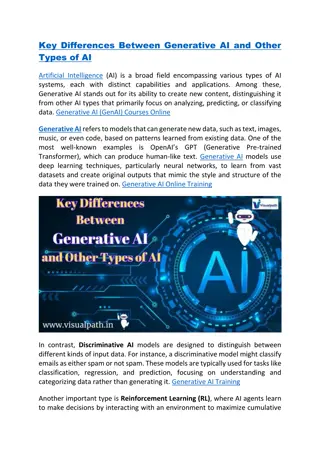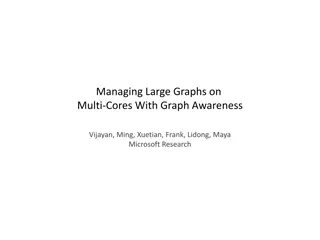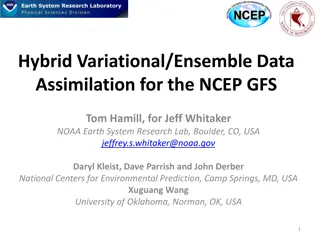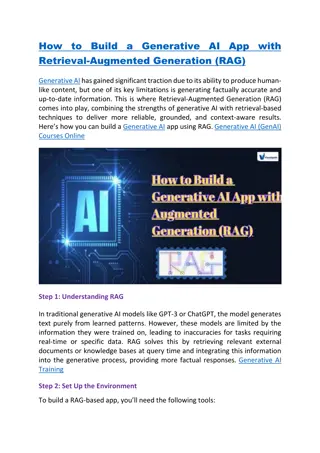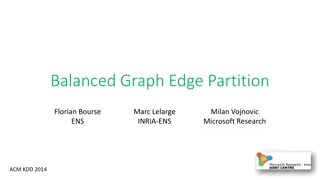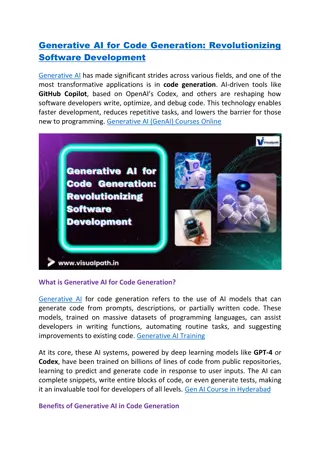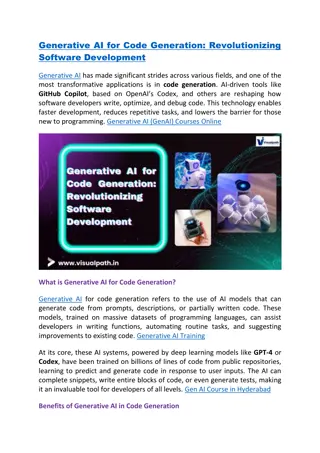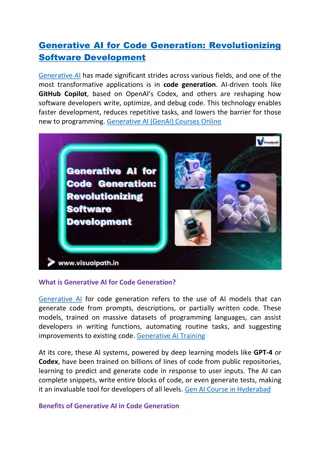Variational Knowledge Graph Reasoning with Generative Models
In this study, the concept of variational inference is applied to resolve intractable objectives in knowledge graph completion tasks. The research outlines methods, experimental results, and concluding remarks, along with exploring existing knowledge graph completion techniques and problem formulations related to missing links in training data. It discusses various KGC methods, such as embedding-based and path-based approaches, and examines KGC from a generative perspective.
Download Presentation

Please find below an Image/Link to download the presentation.
The content on the website is provided AS IS for your information and personal use only. It may not be sold, licensed, or shared on other websites without obtaining consent from the author.If you encounter any issues during the download, it is possible that the publisher has removed the file from their server.
You are allowed to download the files provided on this website for personal or commercial use, subject to the condition that they are used lawfully. All files are the property of their respective owners.
The content on the website is provided AS IS for your information and personal use only. It may not be sold, licensed, or shared on other websites without obtaining consent from the author.
E N D
Presentation Transcript
Variational Variational Knowledge Graph Reasoning Knowledge Graph Reasoning Wenhu Chen, Wenhan Xiong, Xifeng Yan, William Wang Department of Computer Science UC Santa Barbara 1
Outline Outline Introduction to Knowledge Graph Completion Reinterpret the problem as a generative model How to resolve the new intractable objective using variational inference Experimental Results and Conclusion 2
Knowledge Graph Knowledge Graph Las Vegas English serviceLanguage CA personLanguages Caesars Entertain Neal Tom Hanks McDonough castActor serviceLocation nationality awardWinner countryOfOrigin United States Band of Brothers 3
Knowledge Graph Completion Knowledge Graph Completion serviceLocation United States Caesars Entertain serviceLanguage countryOfOrigin Query: ?(Band of Brothers, English) Band of Brothers English castActor personLanguages Neal McDonough 4
Problem Formulation Problem Formulation During Training, we intentionally mask some relations as missing links and use them as training triples: ??????= (??,??,?) ?? = ( ????,?????,????) During Test, we are interested in filling the relation slot given entity pair: ?????= (??,??,?) ?? = ( ????,?????,????) 5
Existing KGC methods Existing KGC methods Embedding-based methods (fast and efficient) TransE, Bordes et al, 2013 TransR/CTransR, Lin et al, 2015 DistMult, Yang et al, 2015 ComplEx, Trouillon et al., 2016 Path-based methods (accurate and explainable) Path-Ranking Algorithm (PRA), Lao et al. 2011 Compositional Vector, Neelakantan et al. 2015 DeepPath, Xiong et al, 2017 Chains of Reasoning, Das et al, 2017 MINERVA, Das et al, 2018 6
KGC from a KGC from a generative perspective generative perspective ?? English tvProgram Language ?(?|??,??) ? ? ? ? ? Band of Brothers ?? Condition Observed Variable KG Latent Variable ? = ??????? ?(?|??,??) = ??????? log ? ? ? ?(?|??,??) ? where prior: ? ? ??,??, and likelihood: ? ? ? 7
Variational Variational Inference Inference Variational Bayesian methods: optimizing intractable integrals: Maximize ELBO as surrogate objective. ??? ?(?) = ??? ? ?|? ? ? ?? KL divergence 0 ???????? ????? ????? (????) 8 DM Blei et. al 2016
Variational Variational Auto Auto- -Encoder (VAE) Encoder (VAE) Variational Auto-Encoder provides an efficient and practical way to perform variational inference. Decoder Encoder 9 DP Kingma et al. 2013
Challenge of VAE in KG Challenge of VAE in KG Existing VAE methods only consider continuous latent vectors: NLP applications: Machine translation (Biao et al. 2016) Text generation (K Guu et al. 2017) Dialogue generation (TH Wen et al. 2017) CV applications: Image classification (DP Kingma et al. 2013) Image captioning (Liwei et al. 2017) Visual question generation (Unnat et al. 2017) We are tackling sequential discrete variables. 10
KG KG Variational Variational Inference ( Inference (KG KG- -VI VI) ) No re-parameterization for ??? ??,??,? Our prior distribution ?? ? ??,?? is trainable We view the sampling of latent variable as a Markov Decision Process ??+2 ??+2 ??+1 ??+2 ??+1 ??+2 ??+1 ?? ?1 ?? ?? ??+1 11
KG KG Variational Variational Inference ( Inference (KG KG- -VI VI) ) We view likelihood ?? (?|?) as a sequence classification model. ????????1 ?? ?? ?1 ??????? ???/??? ????????2 ?? ?2 ?? ????????3 ?? ?? ?3 ?/?3 12
Evidence Lower Bound Evidence Lower Bound ELBO = Reconstruction + KL-divergence Reconstruction Loss ?? ? ??,??,?log? ? ? logp r ??,?? ???? ??(? ? ??,??,? ||?(?|??,??)) KL-divergence where posterior distribution: ? ? ??,??,? 13 DP Kingma et al. 2013
KG KG Variational Variational Inference (KG Inference (KG- -VI) VI) Training with Gradient Descent ???? ??,??,?log??? ? KG connected Path r r ??(?) ?? (?|?) ?? ?? ??(??? ??,??,? ||??(?|??,??)) ?? ?? KG connected Path ?? (?) ?? ?? 14
KG KG Variational Variational Inference (KG Inference (KG- -VI) VI) Testing r ?? (?|?) ?? ?? KG connected Path ?? (?) ?? ?? 15 posterior:??,likelihood:??,prior:??
Comparison with MINERVA (Path Comparison with MINERVA (Path- -Finder) Finder) ? = 1.0 Length/ Success ?? X MINERVA ? = 0.0 ? = 1.0 Das el al.2018 ??????(?|??,??,?) ?? Path-Finder: ????? = ??~??[ ?(?) ] ?? ?(?) = 0.33 Our Model Path- Reasoner ?? X ?(?) = 0.0 ?(?) = 0.8 ? ? = ?? ? ? ????? 16 ??
Dataset Dataset FB15k, link prediction for 20 relations. NELL-995, link predication for 12 relations. Dataset Entity Relation Triple Relations FB15k 14505 237 310116 20 NELL995 75492 200 154213 12 FB15k has more complex reasoning environment ?????? ?????? Dataset Path Length Potential links 22.14= 238? 24= 16 FB15k 22.1 4 NELL995 2 4 17
Evaluation Evaluation Given a list of entity pairs, compute the rank of positive sample as evaluation score +) (??,?,?1 ?1 ? ? ?1 = 0.14 ) (??,?,?2 ?2 ? ? ?2 = 0.2 Beam-Search ) ?3 ?? (?) ? ? ?3 = 0.1 (??,?,?3 ) ? ? ?3 = 0 (??,?,?4 ???? ) (??,?,?5 ???? ? ? ?3 = 0 #????(?+)=1 1 ??? = 2= 0.5 18
Experimental Results on NELL Experimental Results on NELL- -995/FB 995/FB- -15k 15k Variational inference framework performs better under more noisy environment Model NELL-995 FB15k PRA (Lao el al. 2011) 67.5 54.1 TransE (Bordes et al. 2013) 75.0 53.2 TransR (Lin et al. 2015) 74.0 54.0 TransD (Ji et al. 2015) 77.3 - DeepPath (Xiong et al. 2017) 81.2 57.2 RNN-Chain (Das et al. 2017) 79.0 51.2 MINERVA (Das et al. 2018) 88.8 55.2 CNN Path-Reasoner 82 54.2 Our model 88.6 59.8 19
Conclusion and Future Work Conclusion and Future Work Conclusions Our framework can be seen as a new variational inference framework to deal with sequential latent variables. Our model shows its strength to deal with more complex reasoning envrionments. Future Directions Extend our model to resolve more tasks with sequential latent variables. 20 Das el al. 2017
Thanks! PPT Link: https://wenhuchen.github.io/images/naacl2018.pptx Dataset link: http://cs.ucsb.edu/~xwhan/datasets/NELL-995.zip 21
Error Analysis Error Analysis Error Type Positive Sample Negative Sample Path-finder Error (find no paths) (find paths) (find no paths) (find no paths) ?(?|?+) < ?(?|? ) Path-reasoner Error FB-15K ERROR STATISTICS Path Finder 32% Path Reasoner 68% 22
Prior & Posterior Prior & Posterior Posterior distribution L rel3 rel1 rel2 Prior distribution L 23
